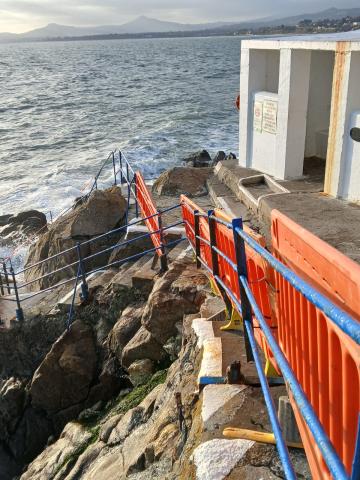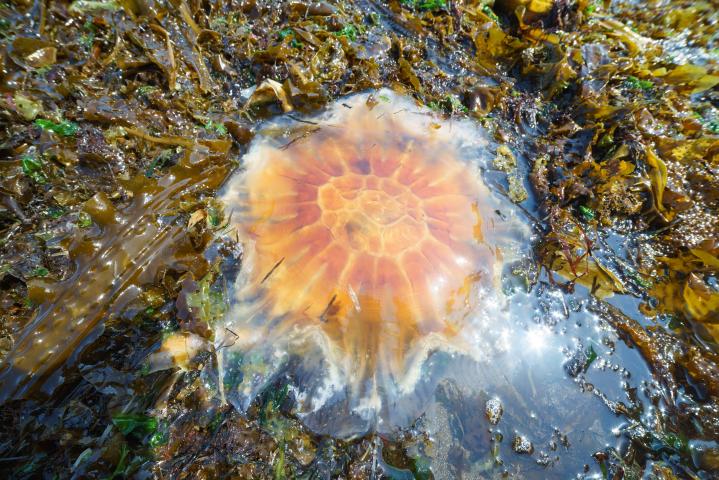Lion’s Mane Jellyfish Alert – Stay Safe on Dún Laoghaire-Rathdown Beaches
Important Notice – Lions Mane Jellyfish
There has been an increase in sightings of Lions Mane Jelly fish over recent weeks.
It is reported that conditions could remain ideal for this type of jelly fish for the remainder of August and into September.
Use the jelly fish ID card to identify any that you may see on Dun Laoghaire Rathdown beaches during your visit to the beach.
The Lion’s Mane is the most serious jellyfish in Irish waters. Lion’s Mane jellyfish prefer the cooler waters of the Irish Sea and especially the waters off Dublin. Recently an increase has been seen in waters off the East Coast and some very large jellyfish have been observed on beaches in this area.
The Lion’s Mane stinging cells are much sharper than other species and can pierce skin easily resulting in a painful sting. Jellyfish stings in Ireland are not usually life threatening and just require basic first aid (see below) and simple pain relief.
A sting from a Lion’s Mane jellyfish can cause nausea, sweating, cramps, headaches and other symptoms.
Your risk of getting stung is increased if you:
- touch jellyfish, so make sure curious children don’t get too close
- swim at times when jellyfish appear in large numbers (a jellyfish bloom)
- swim in a place known to have many jellyfish, especially on a downwind shore
- swim or dive in jellyfish areas without protective clothing
- play or sunbathe where jellyfish are washed up on the beach
Animals are also at risk of getting stung, therefore keep your dog on a lead when walking on the beach.
What to do if you have been stung
- Remove yourself from the water / vicinity of the jellyfish
- If helping someone else make sure you don’t get stung yourself
- Seek help and advice from lifeguards if you are on a lifeguarded beach
- Try to carefully remove any attached tentacles by
- flushing the sting area with sea water
- removing tentacles with gloved hands, clean stick, tweezers, or scraping gently with the edge of a credit card. Don’t try to rub them off.
- Mild symptoms of pain and swelling can be treated with simple painkillers such as paracetamol and ibuprofen
- Mild itching at the sting site may respond to anti-histamine creams
- Apply a 'dry cold pack' to the area (i.e. place a cold pack or ice inside a plastic bag and then wrap this package in a t-shirt or other piece of cloth)
- Keep any puncture wounds clean and dry to avoid them getting infected
Seek medical attention if you develop any serious symptoms
What not to do
- Don’t rub the area
- Don’t rinse with fresh water. Use seawater
- Don’t urinate (pee) on the sting
- Don’t use vinegar for the types of jellyfish stings that might happen in Ireland
- Don’t use alcohol
- Don’t put on a tight bandage
Information is available from HSE here, including a link to the Jellyfish ID Card.
Bathers are asked to research lifeguarded beaches and swim between the flags. Lifeguards will provide information on the safest way to enjoy the beach and will advise on jelly fish presence where possible. Lifeguards may raise the red flag if a large number of jellyfish are present.
Please speak to the lifeguards on the beach before swimming and approach for advice if you are stung.
Lifeguarded beaches in Dun Laoghaire Rathdown County Council area are,
- Seapoint
- Dun Laoghaire Baths
- Sandycove
- Killiney beach
Lifeguards are present on these beaches between 12pm and 6pm Monday to Friday and 11am to 6pm on weekends for the remainder of the month of August, and 11am to 6pm the first two weekends of September.
News
View all
Access restricted at Hawk's Cliff

Free Christmas Tree Recycling in January





